Tile profiles: selection criteria
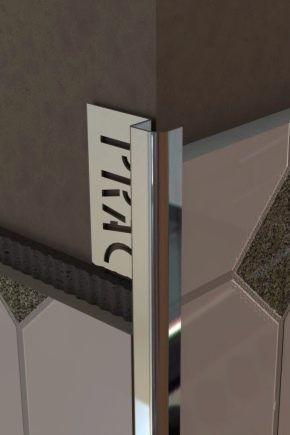
Tile finishing profiles are also called layouts or trims. They cover the tile on two or three sides, masking the raw edges. Layouts are a characteristic feature of modern renovation. Let's figure out how these details are useful, what they are, and on what basis they should be chosen.
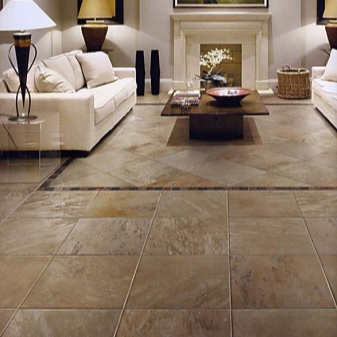
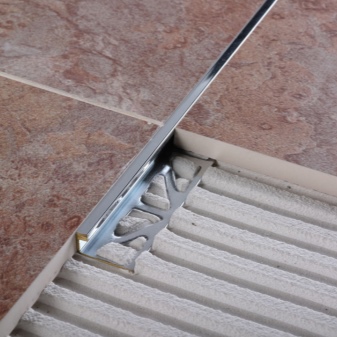
Benefits of using
Making the joints of the tiles in the corners, you can do without a profile. This approach is justified when decorating walls with expensive or embossed tiles.
Masters do not advise giving up the layout just because of its appearance, because it has a lot of advantages:
- The profiles make the bathroom safe. The corner of the sharpened tile turns out to be sharp, it is easy to get hurt about it if you slip on a wet floor. Layout, on the other hand, smoothes such areas.
- It is more convenient to use a profile than to grind tile edges at a 45 ° angle.
- The finish looks more interesting. The connection line turns out to be neat, and a corner that matches the color and texture can emphasize the beauty of the tile.
- Profiles reliably close gaps, protecting the inner part of the wall from moisture. This eliminates the risk of mold or mildew and extends the life of the tiles.
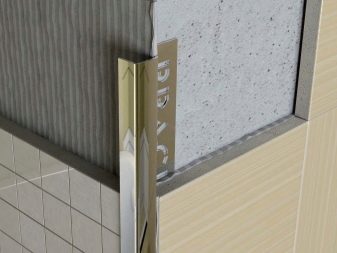
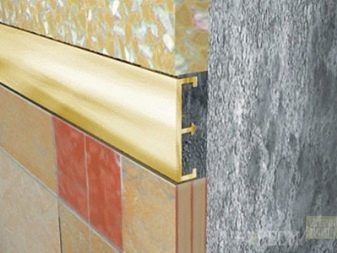
Types and forms
Tile layouts are decorative and functional and decorative. Decorative ones are made of PVC or ceramics and are used to decorate and mask the end sides. This includes the bath curb. Functional and decorative profiles are made of metal. They are not only beautiful but also practical. Such elements do not allow the joints and edges of the tiles to collapse, give the correct shape to the outer corners, and fasten different floor coverings together.
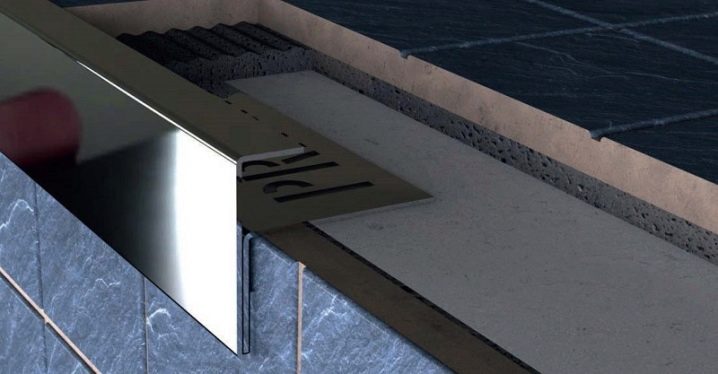
By purpose, all profiles are divided into several groups:
- External edging. They are designed to decorate protruding corners. Such elements consist of two parts: a perforated groove for a tile and an outer side. They protect tiles from damage and have a decorative function.
- Internal edging. This type is used less often than the previous one. The concave bezel smooths out the transition between the sides of the corner piece. Such profiles are often used to form the junction of the bathtub with the plane of the wall.
- End corners for steps. They protect the edges of the tiles from damage. Combined with rubber pads, they make the ladder less slippery. It is advisable to use such elements only indoors.
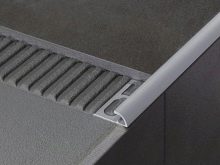
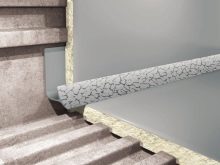
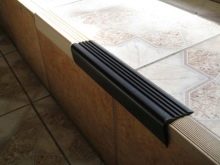
- Compensatory. This type hides expansion joints that compensate for the change in tile size due to temperature changes. Such profiles are required in spacious rooms. They also differ in the presence of decorative overlays.
- Docking. Such products are indispensable when combining tiles with other materials. With a straight joining line, they use rigid steel layouts. Flexible plastic and aluminum profiles are used when the boundary between materials is curved. Recently, a liquid docking profile has appeared, which is a mixture of cork particles and glue.
Craftsmen apply it to the junction of the coatings, and when it hardens, remove the excess.
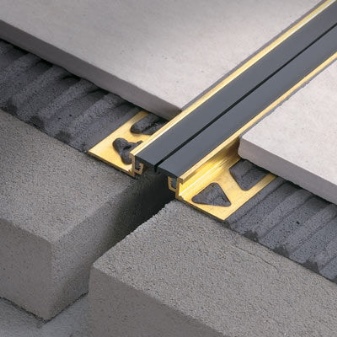
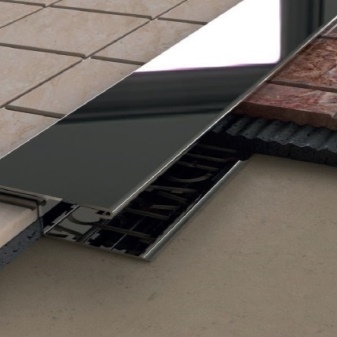
Metal layouts for tiles have different sections. Its shape is determined by the function of the part.
In stores, you can see several options:
- T-shaped layouts are used as docking and compensatory. The thin top and hidden fittings make it almost invisible. The most popular parts are made of aluminum, brass and steel versions are also available.Profiles with a width of 10-14 mm can be bent.
- U-shaped profiles are made from aluminum, brass and steel. They are used as connecting and end. They frame open edges, outer corners and steps.
- L-shaped have the same function as the previous group.
- L-shaped or starters are convenient when working with large tiles. They do not allow the first horizontal row of tiles to "slide" under their own weight.
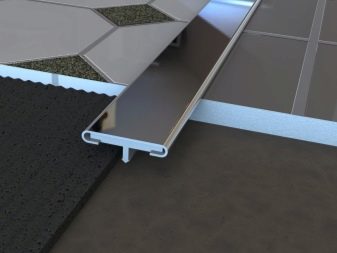
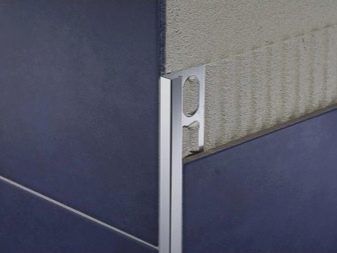
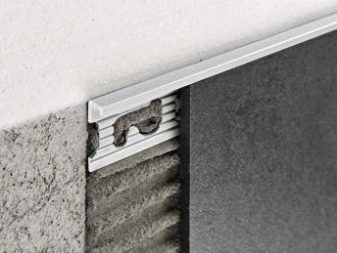

Materials (edit)
Basically, aluminum, stainless steel, brass, PVC and ceramics are used for the manufacture of corners for tiles. Each of them has strengths and weaknesses. Let's consider them in more detail.
- Aluminum. All types of profiles are made from this metal and its alloys. It is a fairly strong and durable material that is not susceptible to corrosion. The connecting aluminum profile can be used for curved floor joints. Colored spraying is applied to the outside of the parts. Shades of precious metals are mainly used, but sometimes bright colors can be seen.
- Brass. It is a tough, wear-resistant, corrosion-resistant alloy. It can withstand high mechanical loads, therefore it is suitable for decorating flooring. The material protects corners, tile edges and seams from damage. Brass profiles are available in natural, polished, chrome-plated and bronze-plated.
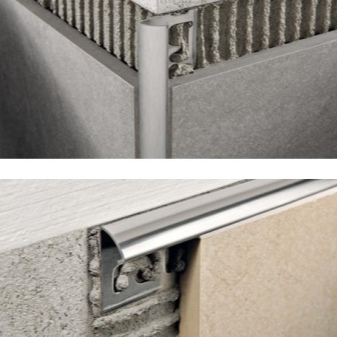
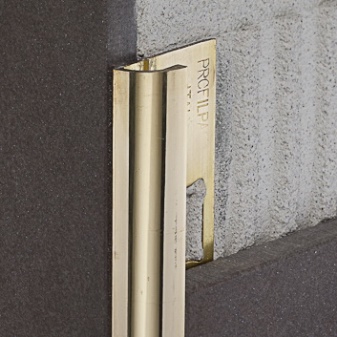
Brass is an expensive and high quality material. In the interior, it looks stylish and luxurious.
- Stainless steel. In terms of technical characteristics, it is similar to brass, but more durable. Such products serve for more than ten years. Stainless steel profiles are available in matt, glossy, polished and embossed. Metal and brass corners are convenient to use together with heavy large tiles.
- PVC profiles are divided into soft and semi-rigid. The main disadvantage of the former is fragility. Parts made from this material are notable for their low price and a variety of colors (from white to dark green and burgundy). PVC profiles are easy to install, do not deteriorate from water and do not require special maintenance, however, they can turn yellow over time.

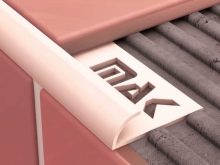
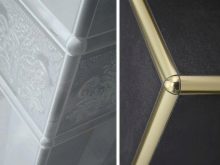
- Ceramics. It is mainly used to decorate the transition between the bathroom and the wall. Such products are beautiful, durable, but they can crack on impact. Details from this material are easily matched to tiles of any shade.
Dimensions (edit)
The size of the edging profiles is characterized by two sizes. The first shows the width of the tile groove, the second shows the length.
The size of the groove varies from 8 mm to 12 mm. Craftsmen recommend choosing a profile 1 mm wider than the thickness of the tile. If the tile still does not fit into the groove, its edge can be carefully grinded off with a grinder.
The standard length of parts is 1 m and 2.5-2.7 m.
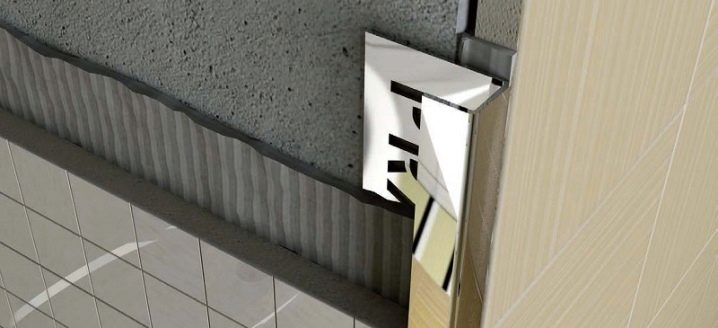
When choosing curly L-shaped and T-shaped profiles, you should pay attention to the number after the article. It is equal to the height of the part. Profiles are available in heights of 6, 8, 10, 12, 15 and 20 mm. The same rule is followed here - tile thickness + 1 mm.
On U-shaped profiles, two numbers are indicated, for example, 10x10, 12x12, 20x10. The first shows the height of the section, the second shows the width.
The standard size of the section of ceramic corners is 5x5 cm, the length is equal to the width of the tile and is 20 cm or 25 cm.
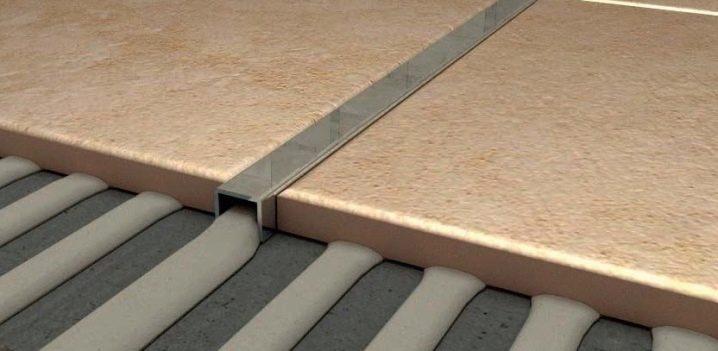
Colors
The richest palette has soft plastic parts. In the assortment of shops you can find more than thirty colors, both bright and pastel. There are layouts with imitation of the surface of metal, different types of stone and ornaments. This allows you to choose a profile that is ideally suited to the design of the tile. Semi-rigid corners are available in only 5-6 colors.
Ceramics is practically not inferior to plastic in terms of the number of shades. Among them there are not only white and several delicate whitened tones, but also saturated colors, including black. In addition, ceramic borders are decorated with painting, relief patterns, gilding and even rhinestones.
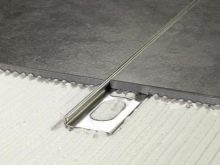
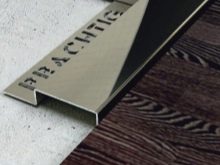

The range of shades of metal parts is not so wide. Basically, it consists of the usual colors for this material (variations of gold and gray).The catalogs often contain: chrome, silver, bronze, gold, black.
How to choose?
Minor details can distort the overall look of the interior, so don't buy ceramic tile profiles at the last moment. Designers advise choosing them as carefully as the tiles.
When buying expensive tiles, you should not save on corners. Plastic layouts make the interior a little unprepossessing, even if they are combined in color with ceramics. Metal parts look stylish in any conditions (even next to cheap tiles).

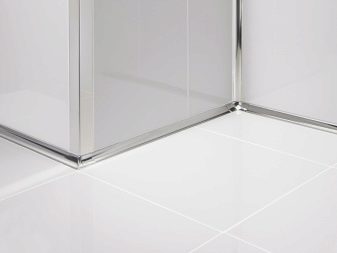
Metal is durable. It will last at least ten years, while plastic will lose its appearance in five years. The metal edging will also reliably protect the edges of the tile from chipping. Therefore, such products are more expensive: aluminum and steel layouts 2.5 m long - from 1000 rubles, brass - from 2300 rubles.
It is important to inspect the item carefully before purchasing. It should be flat along its entire length. It is worth remembering that the size of the groove or the height of the profile must exactly match the thickness of the tile.
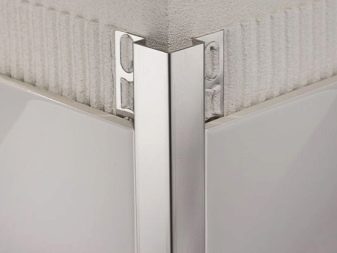
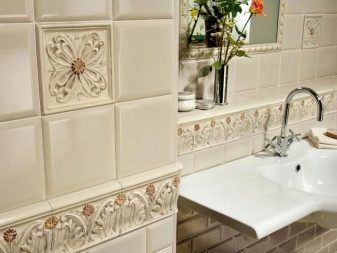
For information on how to install the corners on the tiles with your own hands, see the next video.













The comment was sent successfully.